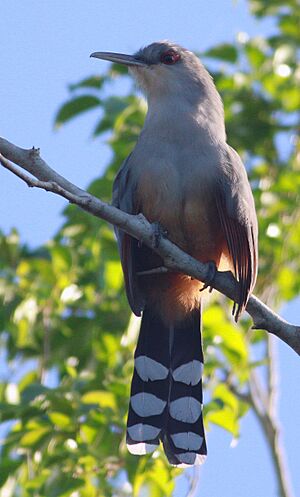Hispaniolan lizard cuckoo facts for kids
Quick facts for kids Hispaniolan lizard cuckoo |
|
|---|---|
 |
|
| Conservation status | |
| Scientific classification | |
| Genus: |
Coccyzus
|
| Species: |
longirostris
|
 |
|
| Synonyms | |
|
Saurothera longirostris |
|
The Hispaniolan lizard cuckoo (Coccyzus longirostris) is a unique bird. It belongs to the cuckoo family, Cuculidae. This bird lives only on the island of Hispaniola. This island is shared by the countries of Haiti and the Dominican Republic.
Contents
About the Hispaniolan Lizard Cuckoo
This cuckoo is part of a group called "lizard cuckoos." There are four types of lizard cuckoos in total. They were once thought to be just one species. These four cuckoos all live on islands in the Caribbean Sea.
The Hispaniolan lizard cuckoo has two main types, called subspecies. One is C. l. longirostris. The other is C. l. petersi.
What Does It Look Like?
The Hispaniolan lizard cuckoo is a medium-sized bird. It is about 41 to 46 centimeters (16 to 18 inches) long. About half of its length is its long tail!
Males usually weigh between 83 and 99 grams (2.9 to 3.5 ounces). Females are a bit heavier, weighing 92 to 128 grams (3.2 to 4.5 ounces).
Both male and female birds look similar. They have a long, straight beak. The top part of the beak is black. The bottom part is lighter.
Adult birds of the main subspecies have gray feathers on their upper body. Their wings are a reddish-brown color. Their throat is reddish, their chest is light gray, and their belly is reddish. Their tail is black. The underside of their tail feathers has large white tips. Around their eye, they have bare red skin.
Younger birds have brownish-gray upper parts. Their throat is whitish. Their tail is brown with buff-colored tips. The C. l. petersi subspecies looks paler overall than the main subspecies. It also has a whitish throat.
Where Does It Live?
The main subspecies of the Hispaniolan lizard cuckoo lives on the island of Hispaniola. It also lives on smaller islands nearby, like Tortuga and Saona. The C. l. petersi subspecies lives only on Gonâve Island, which is off the coast of western Haiti.
These birds like to live in different kinds of places. They can be found in tropical forests. They also live in more open woodlands and thick bushes. You might even spot them in plantations and gardens. They live from sea level up to about 2,200 meters (7,200 feet) high in the mountains.
How It Behaves
Staying Put
The Hispaniolan lizard cuckoo stays in the same area all year long. It does not migrate to other places.
What It Eats
This cuckoo usually looks for food in the middle or upper parts of the forest trees. However, it also hunts closer to the ground. It finds its food by walking along branches.
Its diet includes lizards and small snakes. It also eats many kinds of insects, both adult insects and their young (larvae). Sometimes, it joins groups of different bird species that are hunting for food together.
Reproduction and Nests
The main time for the Hispaniolan lizard cuckoo to have babies is from March to June. The bird builds a flat nest. It uses leaves to make the nest. The nest is often placed on a tree stump or in a tree.
A female cuckoo usually lays two or three eggs. We don't know many other details about how they raise their young.
Its Calls and Sounds
The main sound the Hispaniolan lizard cuckoo makes is a "rattling, grating" call. This call goes down in pitch. It also makes other sounds. These include a harsh "tchk," a clicking sound, and a "tick cwuh-h-h."
Its Conservation Status
The IUCN (International Union for Conservation of Nature) has looked at the Hispaniolan lizard cuckoo. They have listed it as a species of "Least Concern." This means it is not currently in danger of disappearing.
However, we don't know exactly how many of these birds there are. Experts believe their numbers might be going down. There are no big, immediate threats to the bird. It is found widely across the island. But in some parts of Haiti, it is harder to find. In rural areas, people sometimes hunt it for traditional purposes.


